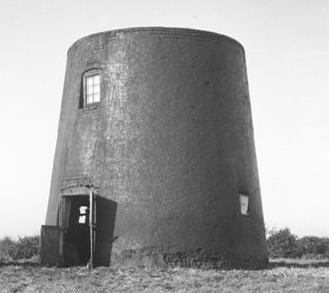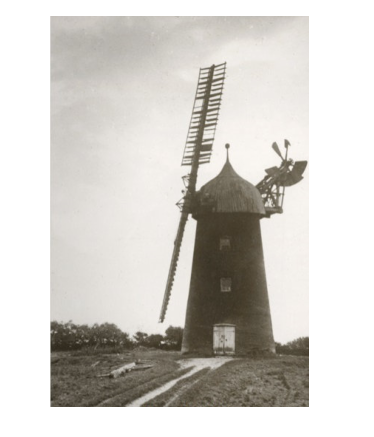Filey’s Windmill
Recreating an iconic building

The
history
of
windmills
on
the
present
site,
as
far
as
the
written
record
goes,
begins
in
the
14th
century
when
a
windmill
was
mentioned
in
an
“Inquisition
Post
Mortem”
which
was
an
English
medieval
record
of
the
death,
estate
and
heir
of
one
of
the
King’s
“Tenants-in-Chief”
otherwise
known
as
feudal
barons.
The
miller
at
that
time
was
William
Reigate
who
paid
an
annual
rent
of
6d
(2.5p
today)
or
a
pair
of
gilt
spurs
to
the
owner
Arnold
de
Buckton.
In
1575
two
windmills
were
recorded
on
the
site;
one
of
them
was
marked
on
Jeffreys’
map
of
1772
and
is
believed
to
have
survived
until
1826.
It
is
mentioned
in
a
deed
of
that
year
as
being
a
“post
mill”
(see
Heritage
Statement
for
description
of
mill
types).
This
was
replaced
in
around
1850
by
the
tower
mill
which
we
see
today.
We
were
extremely
fortunate
to
have
obtained
from
an
internet
search
a
copy
of
a
painting
done
in
1878
which
clearly
shows
the
windmill
and
Mill
Farm
to
which
it
belonged.
It
is
reproduced
below
and
bears
a
striking
resemblance
to
the
same view today.


We
see
the
mill
again
25
years
later.
This
is
a
photograph
taken
by
a
publisher
from
Leeds.
It
was
later
hand-coloured
and
offered
for
sale
as
a
picture
postcard.
Edwardian
visitors
would
send
it
to
family
and
friends
telling
about
the
holiday
they
had
spent
at
Filey.
We
were
delighted
to
find
and
purchase
one
of
the
originals
on
eBay
and
we
have
used
the
image
as
a
header
to
these
web
pages.
As
can
be
seen
the
mill
already
had
two
of
its
four
sails
dismantled,
the
remains
of
them
are
visible
in
the
1910
picture,
lying
alongside
the
cart
track.
This
happened
frequently
when
expensive
repairs
were
needed
but
not
considered
economically
viable.
The
mill
could
still
grind
corn
but
nowhere
near
as
efficiently,
especially when winds were light.
The
next
evidence
of
the
mill’s
decline
comes
from
the
photograph
on
the
right,
taken
by
the
Reverend
Stanwell
in
1910,
after
storm
force
winds
had
wrecked
the
fantail
and
badly
damaged
the
two
remaining
sails.
This
was
the
point
of
no
return
for
the
old
mill
as
shortly
afterwards
the
cap,
sails
and
the
whole
third
storey
were
dismantled
and
a
crude
temporary
roof
made
from
old
floorboards
over
which
concrete
was
poured.
This
kept
the
weather
out
and
incredibly
lasted
until
2010
when
the
present
owners
had
a
very
lucky
escape
-
of
which
more
later!
There
are
several
theories
about
why
the
mill
was
reduced
to
a
“stump”,
which
was
not
an
unusual
occurrence
as
windmills
gradually
fell
out
of
use
around
this
time.
Certainly
the
mechanical
parts
which
remained
intact
would
have
had
a
value
as
spares
for
other
mill
owners.
The
wind
shaft,
the
brake
wheel,
the
curb
and
various
parts
of
the
milling
machinery
would
have
been
especially
valuable.
Removing
the
cap
and
general
“top
hamper”
would
also
serve
to
consolidate
the
structure
and
prevent
further
deterioration.
A
further
possibility
is
that,
following
the
devastation
wreaked
by
the
German
Grand
Fleet
when
they
shelled
Scarborough,
Whitby
and
Hartlepool
early
in
the
First
World
War,
causing
several
thousand
mainly
civilian
casualties,
including
many
deaths,
the
War
Office
anxious
to
remove
any
landmarks
that
might
assist
the
enemy’s
navigation
took
drastic
action.
The
mill
was
clearly
visible
from
the
North
Sea
and
was
used
by
the
local
fishing
fleet
as
a
“mark”
when
entering
the
bay
so
there
was
a
credible
case
for
ordering
it
to
be
dismantled
in
return
for
a
generous
state
subsidy.
Whatever
the
reason,
repairing
the
mill
was
obviously
not
considered
an
economic
proposition
as
it
was
already
becoming
apparent
that
the
age
of
wind
power
was
passing.
Steam
and
electricity
were
proving
more
reliable
sources
of
power
than
the
ever
changing
strength
of
the
wind
and
the
arrival
of
the
railways
made
the
transport
of
grain easier and less expensive.

The
next
sighting
we
get
is
the
photograph
below
taken
by
William
Muggeridge
in
1955.
It
had
survived
intact
through
the
Second
World
War
providing
storage
for
the
farmer
and
shelter
for
his
animals
during
those
turbulent
times
and
had
been
well
maintained
over
the
45
years
since
we
last
saw
it;
its
windows
and
doors
were
intact
and
it
looks
in
reasonably
good
condition.
Unfortunately
this
state
of
affairs
did
not
last.
An
unknown
photographer
took
the
shot
on
the
right
in
1980
and
despite
its
poor
quality
we
can
clearly
see
the
mill
has
been
totally
neglected
for
a
long
time
and
appears
to
be
in
a
very
sorry
state.
The
windows
and
doors
have
rotted
away,
weeds
are
growing
out
of
the
roof
and
the
protective
pitch
coating
had
almost
all
gone.
It
is
obviously
still
proving
of
some
use
to
the
farmer
as
an
animal
shelter
but
clearly
it
was
having
no
money
spent
on
it
and
being
allowed
to
become dilapidated.

Muston Mill 1955

Muston Mill 1980
Finally
and
sadly
we
see
the
mill’s
desperate
condition
when
we
purchased
the
field
in
2002.
It
is
hard
to
believe
it
possible
to
bring
it
back
to
its
former
impressive
stature
standing
tall
once
again
on
the
hill
above
the
town.
Despite
this
after
15
years
research,
hard
work
and
a
steadfast
refusal
to
admit
defeat
in
the
face
of
adversity
we
are
already
well
on
our
way
to achieving that goal.


Muston Mill 2002
The
last
photograph
on
this
page
was
taken
in
the
spring
of
2011.
It
gives
the
reader
a
glimpse
of
the
mill
after
we
had
carried
out
emergency
repair
work
and
made
the
building
weatherproof
and
secure.
Fortunately
permission
was
not
needed
to
do
this
as
the
inevitable
long
delay
would
have
meant
it
would
be
too
late
for
us
to
save
the
fast
crumbling
structure
from
complete
ruin.
The
next
page
lists
details
of
the
work
we
did
to
provide
protection
for
the
structure
thus
gaining
the
time
necessary
to
complete
our
twelve
year
struggle to obtain planning permission.
The Sad Story of Muston Mill’s Decline
The
years
rolled
by
and
the
mill,
now
much
reduced
in
stature,
sat
in
its
field
without
anything
of
note
taking
place.
We
next
meet
it
in
1942
during
the
Second
World
War
when
one
of
our
twin-engined
Wellington
bombers
piloted
by
an
Australian
crew
ran
out
of
fuel
returning
to
Leconfield
from
a
mission
and
was
fortunately
able
to
make
a
forced
landing
in
the
mill
field.
The
crew
were
unhurt
and
the
aircraft
was
not
very
badly
damaged
as
can
be
seen
from
the
photograph
inset.
The
mill
itself
is
just
out
of
view on the right hand side.

Powered by Xara Web Designer



Muston Mill 1904
Muston Mill 1910


Muston Mill 2011













